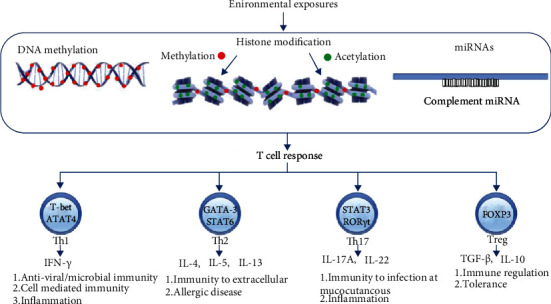Figure 2.

The role of epigenetics in the pathogenesis of asthma. An epigenetic mechanism links genetic and environmental factors with developmental trajectories in asthma. The most commonly studied asthma epigenetic phenomena are DNA methylation, histone modifications, and miRNAs. DNA methylation is the process of adding methyl groups, by DNA methyltransferase, on cytosine at position 5 with the formation of 5-methylcytosine [18] where guanine nucleotide follows the cytosine nucleotide known as CpG [19]. The methylation of CpG islands (clusters of CpG) results in gene activation or inhibition, but usually repression, because the islands are found almost near the genes' transcription start site (TSS) [23]. Histone modification usually occurs at N-terminal with possible modifications on each “basic” residue, but common residue targets for modifications are lysine, serine, arginine, and tyrosine threonine. Acetylation, methylation, phosphorylation, ubiquitination, and sumoylation are well-known histone modification mechanisms. Histone acetylation and histone methylation are the most studied and better known to us [82]. Histone acetyltransferases (HATs) and histone deacetylases (HDACs) work in opposition to each other as acetylation by HATs favors gene expression and deacetylation by HDACs is responsible for gene silencing. The addition of phosphate, i.e., phosphorylation, is mediated by kinases, while phosphatases remove the phosphate. Similarly, histone ubiquitination is mediated by ubiquitin ligases and opposed by ubiquitin-specific peptidases, also known as deubiquitinating enzymes. Histone sumoylation is mediated by the histone sumoylation proteins, also known as the small ubiquitin-like modifier (SUMO) protein. A microRNA (miRNA) is a 22-25 nucleotide single-stranded small noncoding RNA molecule transcribed from the DNA. However, miRNAs are not translated into proteins and play a role in gene expression either by blocking or by altering mRNA translation stability [86]. Alteration in epigenetic status results in differential gene expression related to cytokines and transcription factors, resulting in various and distinct phenotypic presentations in asthma. Some T cell subsets and cytokine production and functions are also shown in the figure. miRNAs: micro-RNAs; Th cells: T helper cells.
